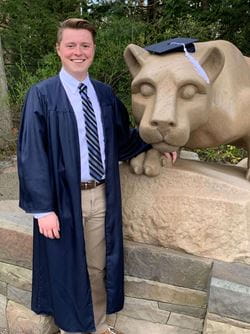Ross Ivey was only 17 when he experienced back-to-back ministrokes, or transient ischemic attacks (TIAs). That led to a diagnosis of moyamoya — a rare cerebrovascular disease — and neurosurgery at UPMC Children’s Hospital of Pittsburgh to create a new pathway for blood to flow to his brain.
Frightening Events
At home alone in Gibsonia, Pa., rising high school senior Ross Ivey was enjoying the last weeks of summer vacation when he felt a strange, tingling sensation along the right side of his body and arm.
“I just brushed it off. I was on the computer, so I just thought my arm went to sleep or I pinched a nerve,” says Ross.
The sensation quicky subsided. But a couple hours later at dinner, he mentioned it to his mother.
“I didn’t realize at the time, but my mom noticed I was talking funny. My speech was slurred, and the right side of my face drooped. She thought I was having a stroke,” says Ross.
“One minute I was having dinner, the next minute I was in an ambulance headed to UPMC Children’s.”
A Rare Diagnosis
At Children’s, doctors determined that Ross had experienced two transient ischemic attacks (TIAs) — also known as ministrokes. But the doctors still needed to determine the cause.
 Ross spent several days at Children’s undergoing neurological tests, bloodwork, imaging scans, and other diagnostics tests. He was eventually diagnosed with moyamoya disease — a rare and serious problem involving blood flow to the brain. It occurs when the carotid arteries and their branches in the head that supply blood to the brain become narrow. The word “moyamoya” is a Japanese term meaning “puff of smoke,” which describes the cloud of dilated tiny arteries seen on angiogram in patients with this condition.
Ross spent several days at Children’s undergoing neurological tests, bloodwork, imaging scans, and other diagnostics tests. He was eventually diagnosed with moyamoya disease — a rare and serious problem involving blood flow to the brain. It occurs when the carotid arteries and their branches in the head that supply blood to the brain become narrow. The word “moyamoya” is a Japanese term meaning “puff of smoke,” which describes the cloud of dilated tiny arteries seen on angiogram in patients with this condition.
Because moyamoya decreases blood flow to the brain, it increases the risk of a TIA or stroke. Without surgery, moyamoya can lead to serious neurologic problems, including paralysis, blindness, and death.
When Ross learned he would need brain surgery, he was understandably frightened.
“I was upset and scared. Brain surgery is a big deal,” says Ross.
Ross and his parents met with Stephanie Greene, MD, a pediatric neurosurgeon at UPMC Children’s Hospital of Pittsburgh, where she serves as director of both vascular and perinatal neurosurgery and as co-director of the Neurovascular Center of Excellence.
The disease can occur on both sides of the brain, but Ross only had a blockage in a major branch of the left carotid artery. Dr. Greene explained how she would perform an arterial bypass using an artery taken from outside the brain to create a new pathway for blood.
“Dr. Greene did a good job of explaining things. I understood she was very proficient and an expert in treating moyamoya,” says Ross. “I felt confident she knew what she was doing.”
A “Last” Hurrah
At the time of his diagnosis in August 2015, Ross was about to start his senior year at Pine-Richland High School. He also played the trombone, and had been named drum major of the school marching band. The honor student was making plans for college and a degree in mechanical engineering.
 Surgery was scheduled for Aug. 25 — the first official day of school. With a free week and a half before surgery, Ross focused on living as normal a life as possible — attending band camp, hanging out with friends, swimming, going on a date, and visiting Kennywood. He also applied to three colleges, including Penn State University.
Surgery was scheduled for Aug. 25 — the first official day of school. With a free week and a half before surgery, Ross focused on living as normal a life as possible — attending band camp, hanging out with friends, swimming, going on a date, and visiting Kennywood. He also applied to three colleges, including Penn State University.
“I felt perfectly normal, so I decided to do this last hurrah stuff. I wanted to enjoy life in case something bad happened,” he says.
“I enjoyed that last week. But all I really remember is wanting to be a normal kid again. I couldn’t wait to get it over with.”
Reassurance and a Smooth Surgery
Back at Children’s, Doreen Soliman, MD, a pediatric anesthesiologist with special expertise in minimizing the stroke risk of moyamoya with anesthesia, talked to Ross and his parents before surgery. She patiently explained how she would ensure that he would go through the procedure without any pain, memory, or movement. He would remain asleep — with careful monitoring and maintenance of his heart rate, blood pressure, breathing, temperature, and oxygen level — until the medicine was taken away.
“She helped ease my fears and worries. She also told me I was in very good hands,” says Ross. “It was very comforting.”
In the operating room, Dr. Greene performed a procedure known as a pial syangiosis, an indirect bypass of the blockage. After creating a hole in his skull, she took a scalp artery and placed it on the surface of his brain. This allows new blood vessels to grow from that artery into the brain, forming a new blood supply over time. She then replaced the bone so that the scalp artery was now inside the skull.
“The surgery went perfectly. I just needed time for everything to heal and for the artery to grow,” says Ross.
A Cautious Recovery
Two days after his 5-hour surgery, Ross returned home to recover. He spent the first month at home resting before he was allowed to venture anywhere.
“I mainly felt weak and very tired. I was excited to see people when they came to visit, but I kept falling asleep,” he says.
 He returned to school in early October, initially going for half-days. Within a couple months, he had resumed marching band, but was not allowed to play the trombone because of the narrowing of the arteries in the brain caused by blowing.
He returned to school in early October, initially going for half-days. Within a couple months, he had resumed marching band, but was not allowed to play the trombone because of the narrowing of the arteries in the brain caused by blowing.
“Physically, I was back to normal, but I still needed time for my brain to heal and for the artery to grow,” explains Ross. “Other than playing the trombone, I had no restrictions. I just had to take aspirin and drink lots of water to stay hydrated.”
By late fall, Ross had been accepted into three colleges. He chose Penn State, his parents’ alma mater, where he was accepted into the engineering school. He made plans to audition for the University’s marching band but had to wait until the summer to begin practicing.
“I had one month to practice and get in shape,” says Ross. “Your lips are muscles. I had to get my lips in shape and get my lung capacity back. And I had to reacquaint myself with the music.”
Living a Normal Life
One year after his brain surgery, Ross was living his dream as a college student and a member of the Penn State Marching Blue Band. In addition to marching before and during halftime of home football games and some away games, he marched with the Blue Band at the Rose Bowl in 2017 in Pasadena, Calif., and the Cotton Bowl in 2019 in Arlington, Texas.
“The Blue Band was the best experience of my life. Through the band, I met all my closest friends, had these great experiences, got to go to cool places, and meet people,” says Ross.
In 2020, Ross graduated from Penn State with a degree in mechanical engineering. Now 25 and living in Pittsburgh, he works on railway signal systems and positive train control for a local engineering firm.
For four years after his surgery, Ross had yearly MRIs and follow-up appointments with Dr. Greene. He now has MRIs every other year. His next appointment will be with a UPMC Presbyterian adult neurosurgeon with expertise in moyamoya who was recommended by Dr. Greene. After ten years, he will not need any more MRIs.
“I’ve come so far since having that TIA and being scared, having brain surgery, and going through a long recovery. Thankfully, this disease had a minimal impact on my life,” says Ross. “Dr. Greene saved my life. She gave me the opportunity to live a normal life without living in fear of having a stroke. And I’m very grateful.”









